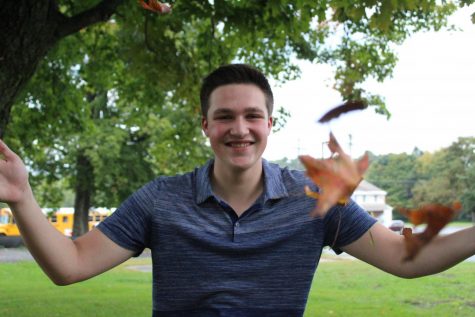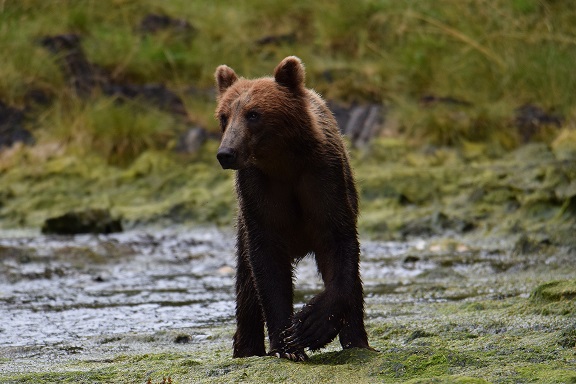Wildlife Photography: Patience is a Virtue
This August, I went to Alaska with my mom, dad, and brother on a family vacation. I have always been interested in photography and I have purchased some camera equipment recently in order to further pursue my interest. On this trip, I took my Nikon D3300 camera along with three different lenses: a 18-55mm lens for close shots, a 55-300mm lens for mid-range shots, and a 150-600mm lens for animals that are farther away. Sometimes, I even use my iPhone X for landscape photography, especially when I do not have time to switch out my big lens.
While I had the opportunity to photograph a variety of different animals on this trip, I was most interested in taking pictures of bears. Towards the middle of our stay, my mom and I flew out of Juneau on a float plane with our guide Bjorn through the Pack Creek Bear Tour company. It was only a four person plane, which was pretty scary at first, but the views were absolutely breathtaking. We landed on the water and hopped off the plane onto Chichagof Island, which is believed to contain the highest population of bears per square mile in the world. It is also the island where the family from one of my favorite shows the “Alaskan Bush People,” lived. As we walked along the beach to the viewing area with Bjorn, he told us to make lots of noise to not startle any bears that may be laying in the nearby brush. This was very alarming, but based on all of the reviews I read on TripAdvisor, the majority of people had a great time and nobody had been attacked by a bear, yet.
Bjorn brought out a bench from the woods that we all could sit on to wait for the bears to show up. We overlooked a waterfall falls leading down into a shallow stream that led into a deeper river. Bjorn informed us that there was a drought occurring in Southeast Alaska, and that the bears usually fish directly below the falls, but it seemed to be too shallow for the salmon to make the jump from the river to the stream. The river below was also too deep for most bears to fish in and catch something successfully. However, after sitting for about fifteen minutes, we saw a young female brown bear emerge from the woods and come down to the river. She looked very skinny and our guide informed us that she would need to eat over half her body weight before hibernating for the winter. The female waded into the water, and eventually caught a Sockeye Salmon. She then retreated back into the woods to eat the fish. I was able to capture hundreds of photographs of the bear by using a high shutter speed and my large lens. It was insane that we were just across the river from this bear! After this, I did have to have some patience and just keep looking around. No other bears emerged for quite some time, but the same female bear eventually came back out.
This is when I was able to photograph her best as I watched her bask in the sunlight underneath the waterfall and try to catch another fish down in the deep river below. She would stand on top of rocks and look for fish in the water below and even swim as well. At one point, the bear came so close to us that the guide had to pull out his bear spray! Luckily, he did not have to use the spray, but Bjorn did mention that the young, hungry females are the bears that he is most afraid of, because they are more aggressive than the larger males. All in all, that bear was the only brown bear we were able to see, which was a little disappointing, because I wanted to see more, but it was still an incredible experience! We were very grateful, because some people have gone and seen nothing at all. Throughout that experience of waiting for hours on a bench, I learned that patience is a major part of wildlife photography.
Later on in the trip, I had read on TripAdvisor about a mother black bear and her three cubs that fish near the Mendenhall Glacier that we had visited previously. When we went there earlier in the trip, it was midday and I read that the bears only come out to fish late at night and early in the morning. Since the Mendenhall Glacier was only about fifteen minutes from our hotel in Juneau, my dad and I decided to go back the morning before we flew home. We got there at about 6:30 in the morning and I had my big lens attached. My dad and I talked to some people that were there as well and asked them if they had seen any bears. There were many trails around and so we walked almost all of them trying to scope them out. One of the ladies we had talked to said that she had watched the bears fishing in a river underneath a bridge at about 9:00 pm the previous night. So, we went up there but there were no bears in sight. Even though I had been patient before when viewing the bear on Chichagof Island, I told my dad that there was no point in standing around because we were not going to see any bears here.
My dad agreed and we left to go pick up some things at the local grocery store in Juneau. I called my mom to tell her that we did not see any bears and decided to just quit. My mom was not very happy about this, because we had only stayed at the trails for about an hour, but I was very impatient since it was early in the morning and I was super tired. She told us to get out of the grocery store and go back, because we might as well try and see if the bears showed up while we were gone. So, I reluctantly hopped back into the car with my dad and we drove back to the trails near the Mendenhall Glacier. We went back to the bridge where the lady had seen the bears the night before, and sure enough we saw the mother black bear fishing in the stream below. She was so close that I had to grab my mid-range lens! I also spotted her three cubs sitting and playing on the bank beside the river, watching as their mother fished. Once the mother caught the fish, she would go into the woods and the cubs would walk across the river and follow their mother. When they were done eating the fish, the mother would come back out and the cubs would again play on the side of the bank while they watched their mother fish. This occurred multiple times and I was able to photograph all of it. I switched to my big lens at one point in order to get some close up shots.
The curious cubs did come a little too close for comfort at the end and a little boy almost touched one of them! A retired forest ranger was present and she proceeded to yell at the little boy and his mother. This scared the cubs off and they scurried away onto the trail as their mother followed them. This day definitely taught me that I need to be patient if I want to photograph animals, because if my mom had not made me go back I never would have gotten the opportunity to take beautiful pictures of the mother and cubs. If I had just stayed at the Mendenhall Glacier and been patient, I would have been there all along. Patience is an essential characteristic for a photographer to have in order to obtain that perfect shot.

Alex Malanoski is a Senior and loves to sing as well as draw in his free time. He also participates in GTV, and of course EMC. Alex is the treasurer of...


Siela Zembsch • Nov 28, 2018 at 10:30 pm
Those photos are so stunning!!
Paula Robarge • Nov 28, 2018 at 8:20 am
What an awesome story. Patience is a virtue only a mother knows! What a beautiful shot of the bear. You have so much talent Alex. Can’t wait to read your next story and see more gorgeous pictures. You capture it all!